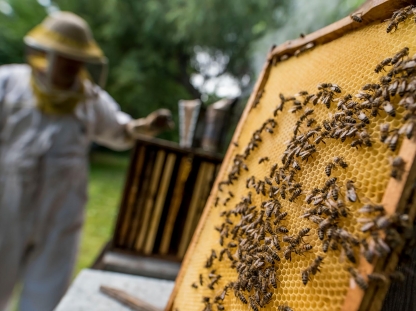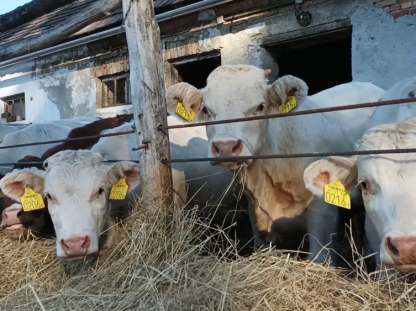A future without bees?
Let’s do something for them instead on the World Bee Day (too)!
Bees – both honeybees and wild bees – are nature’s most important pollinators, and without them it wouldn’t only be the honey on our toast we would be missing, but about 70% of our agricultural plants would not be able to yield any fruits or crops either.
It is true that our most important food crops such as grains, corn and rice are wind-pollinated, but this is an enormous problem regardless. Bees are indicator species, their numbers reflect the general condition of the environment, and their disappearance suggests hidden contaminations and the negative effects of industrialized agriculture.
And bees have been giving warning signs for a long time now. For example, no bees have been spotted outdoors in Sichuan province in China for a long time, and fruit trees are being pollinated there by people, using small brushes. This has been the reality there for years. Excessive use of pesticides, urbanization, the shrinking of natural habitats, climate change and viruses have all contributed to the alarming decrease in the number of bees. Unfortunately, this is a global phenomenon. All these causes sound familiar, and from 2020, it is not only the bees that are feeling the impacts, we are too.
Bees are disappearing now, but the future is in our hands.
Let’s understand bees better and do something to protect them.
The most well-known bee species is the honeybee (Apis mellifera), but there are also 700 wild bee species in Hungary and over 200,000 species worldwide. They are called wild bees because of where they live, and not their behaviour. There have been many on the close relationships between varied land usage, the presence of natural habitats and the survival of pollinators, particularly bees. In a recent American study (Ashley et al., 2020), a comparison was made to reveal the correlations between the diversity and population of wild bees living in intensive agricultural areas and between the health of honeybees and the diversity of plants cultivated on farms. Interestingly, they did not find more wild bees on farms where intensive vegetable and fruit production was performed in addition to soy cultivation. Moreover, while the soy was blooming, even more wild bees visited the farms involved in monoculture soy cultivation. However, this difference can be attributed to the presence of four wild bee species common on soy farms. When analysing the weight of honeybee families and the number of adult workers, it became clear that farms that grow multiple plant species simultaneously provide somewhat more favourable conditions than soy plantations.
A study comparing monoculture and more diverse forms of agriculture, came to the general conclusion that intensive agricultural areas in themselves do not provide continuous and sufficient food sources for bees. In organic agricultural areas we know that the number and diversity of pollinators are higher than in conventional agricultural areas (Hausmann et al., 2020), but in order to stop the global decrease observed in wild bee and honeybee populations, we need to do more. The ratio of semi-natural habitat patches needs to be significantly increased in agricultural areas. Leaving or planting interrow vegetation in plantations, conserving the strips between arable fields and the sources of wild flowers on uncultivated areas, well-planned mowing of grasslands and (in countries where intensive animal rearing is performed) more extensive pasturing are essential for all pollinators.
What can you do to protect honeybees and wild bees?
- Plant smart! Plant multiple kinds of plants that do not bloom at the same time.
- Avoid using pesticides or insecticide products in your garden that are hazardous or risky to bees.
- Instead of a golf course lawn, plant a diverse lawn or one with wild flowers.
- Follow bee-friendly technologies in your garden at home too: apply pesticides classified as moderately dangerous for bees – in case the certification of the pesticide allows it – only after honeybees finish their active daytime flying, starting one hour before the astronomical sunset at the earliest and lasting until 11 pm at the latest.
- Build a bee hotel.
What can farmers do to protect bees?
- Do not leave interrows fallow: plant and grow diverse cover crops.
- Leave the natural vegetation at the edges of cultivated fields.
- Plan to include nectar plants in the crop rotation each year.
- Comply with the requirements in the blooming period and avoid using pesticides that are hazardous or risky to bees. These restrictions extend to the periods outside the blooming period if the field or its surroundings are covered with melliferous plants that bloom in large batches or if the cultivated plant is visited by bees for any other reason.
- Always comply with the requirements of bee-friendly technologies. This is particularly important when applying combinations of pesticides, even if the active substances are not subject to mandatory labelling, because these substances can enhance each other’s effect and can pose an increased risk to bees.
World Bee Day might be a great opportunity to make changes, but we can only expect real results if we act like this every day.
References:
Ashley et al. (2020) Diversified Farming in a Monoculture Landscape: Effects on Honey Bee Health and Wild Bee Communities https://doi.org/10.1093/ee/nvaa031
Hausmann et al. (2020) Toward a standardized quantitative and qualitative insect monitoring scheme https://doi.org/10.1002/ece3.6166








